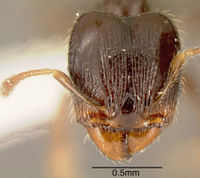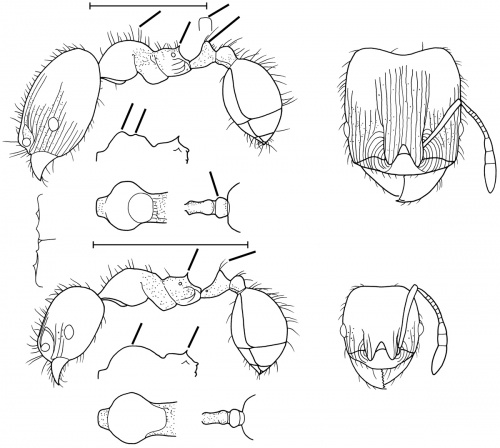Pheidole lucaris
| Pheidole lucaris | |
|---|---|

| |
| Scientific classification | |
| Kingdom: | Animalia |
| Phylum: | Arthropoda |
| Class: | Insecta |
| Order: | Hymenoptera |
| Family: | Formicidae |
| Subfamily: | Myrmicinae |
| Tribe: | Attini |
| Genus: | Pheidole |
| Species: | P. lucaris |
| Binomial name | |
| Pheidole lucaris Wilson, 2003 | |
The type colony was collected in Atlantic lowland rainforest. (Wilson 2003)
Identification
See the description in the nomenclature section.
Keys including this Species
Distribution
Only known from the type locality.
Latitudinal Distribution Pattern
Latitudinal Range: 10.35° to 10.3085492°.
| North Temperate |
North Subtropical |
Tropical | South Subtropical |
South Temperate |
- Source: AntMaps
Distribution based on Regional Taxon Lists
Neotropical Region: Brazil (type locality), Costa Rica.
Distribution based on AntMaps
Distribution based on AntWeb specimens
Check data from AntWeb
Countries Occupied
| Number of countries occupied by this species based on AntWiki Regional Taxon Lists. In general, fewer countries occupied indicates a narrower range, while more countries indicates a more widespread species. |

|
Estimated Abundance
| Relative abundance based on number of AntMaps records per species (this species within the purple bar). Fewer records (to the left) indicates a less abundant/encountered species while more records (to the right) indicates more abundant/encountered species. |

|
Biology
Castes
Worker
Minor
Images from AntWeb
  
| |
| Worker. Specimen code casent0635484. Photographer J. Longino, uploaded by University of Utah. | Owned by INBio. |
Nomenclature
The following information is derived from Barry Bolton's Online Catalogue of the Ants of the World.
- lucaris. Pheidole lucaris Wilson, 2003: 446, figs. (s.w.) BRAZIL.
Unless otherwise noted the text for the remainder of this section is reported from the publication that includes the original description.
Description
DIAGNOSIS A medium sized, concolorous brown member of the flavens group characterized in the major by a somewhat flattened head in side view; relatively long, abundant, erect hairs on the mesosoma, waist, and gaster; short, equilateral propodeal spine in side view; longitudinal carinulae (but no rugoreticulum) covering the anterior dorsal half of the head, with middle section of clypeus smooth; postpetiolar node seen from above trapezoidal; and mesosoma mostly smooth and shiny.
Similar in some but not all of these traits to Pheidole chalca, Pheidole delicata and Pheidole ulothrix, and differing in others, as well as in additional details of body form, sculpturing, pilosity, and color, as variously indicated.
MEASUREMENTS (mm) Holotype major: HW 0.82, HL 0.92, SL 0.54, EL 0.14, PW 0.44. Paratype minor: HW 0.44, HL 0.50, SL 0.40, EL 0.08, PW 0.28.
COLOR Major: body dark brown, appendages medium brown.
Minor: body medium brown, tarsi yellow, and remainder of appendages light brown.
Figure. Upper: holotype, major. Lower: paratype, minor. Scale bars = 1 mm.
Type Material
BRAZIL: Caraguatatuba Reserve, São Paulo state, 40–80 m, col. William L. and Doris E. Brown. Museum of Comparative Zoology
Etymology
L lucaris, from a grove, referring to the type locality.
References
- Wilson, E. O. 2003. Pheidole in the New World: A dominant, hyperdiverse ant genus. Harvard University Press, Cambridge, MA. (page 446, fig. major, minor described)
References based on Global Ant Biodiversity Informatics
- Longino J. T. L., and M. G. Branstetter. 2018. The truncated bell: an enigmatic but pervasive elevational diversity pattern in Middle American ants. Ecography 41: 1-12.

